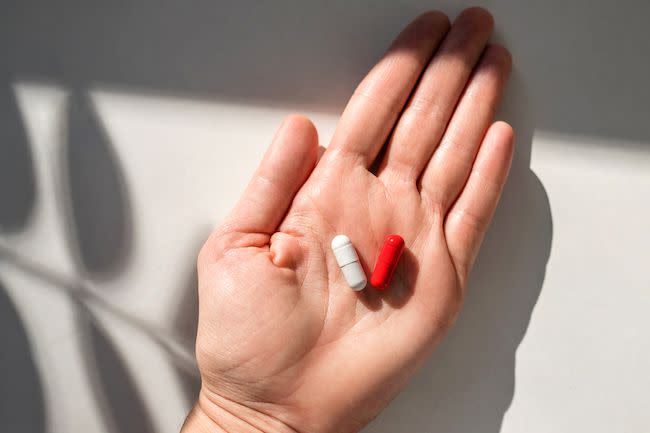Comparing Prozac vs. Lexapro

Medically reviewed by Alex Yampolsky, PharmD
When looking to treat depression or other commonly diagnosed mental health conditions, your healthcare provider may prescribe Prozac or Lexapro.
While the two drugs may sound familiar or interchangeable, they contain some key differences.
Prozac (fluoxetine) and Lexapro (escitalopram) are Food and Drug Administration (FDA)-approved prescription drugs for major depressive disorder (MDD), commonly known as depression).
Prozac and Lexapro are in a class of antidepressant drugs called selective serotonin reuptake inhibitors (SSRIs). They work by increasing levels of serotonin in the brain.
Prozac contains the active ingredient fluoxetine, and Lexapro includes the active ingredient escitalopram.
Prescribed for more than depression, both drugs treat other mood disorders, such as anxiety.
This article will compare Prozac and Lexapro, including their specific indications, side effects, warnings, standard dosages, and other important information.

Prozac vs. Lexapro Differences
While Prozac and Lexapro are similar, they share some significant differences.
How Do They Work?
Prozac and Lexapro, as SSRI antidepressants, work the same way:
Serotonin is usually reabsorbed by nerve cells in the brain. SSRIs block this absorption, increasing serotonin levels in the brain.
Serotonin is a chemical messenger called a neurotransmitter. It involves mood, sleep, appetite, memory, social behavior, and sexual desire.
Indications
Prozac and Lexapro are in the same drug class and work similarly but differ slightly in their indications (uses).
Prozac is FDA-approved to treat:
MDD
Prozac is sometimes prescribed off-label (for an un FDA-approved use). Some examples of off-label Prozac use include:
Lexapro is FDA-approved to treat:
MDD
GAD
Lexapro is sometimes prescribed off-label. Some examples of off-label Lexapro use include:
Panic disorder
Irritability associated with autism
Social anxiety disorder
Together, fluoxetine and olanzapine are available as a combination medication under Symbyax.
Symbyax can treat depressive episodes associated with bipolar I disorder and treatment-resistant depression.
Which Drug Lasts Longer?
Prozac is eliminated from the body slower than all other SSRIs, including Lexapro.
However, it's important to note that either antidepressant can take up to several weeks to start working and up to several months to see the full effect.
Prozac and Lexapro are both SSRIs (antidepressants), and both are used to treat depression.
Prozac is sometimes used off-label for anxiety, while Lexapro is FDA-approved to treat anxiety. Each drug has various uses and off-label uses.
Which Is More Effective: Prozac or Lexapro?
SSRIs like Prozac or Lexapro are often used as a first treatment choice for depression. This is because they are considered to be safe and effective. They are also better tolerated than certain other types of antidepressants.
However, some recent studies reviewed the two drugs to determine whether one is more effective.
Analysis of Governmental Guidelines
A recent article published in American Family Physician reviewed guidelines from the United States Department of Veterans Affairs and Department of Defense (Va/DoD), the American Psychological Association (APA), and the American College of Physicians (ACP), which are widely referred to in the treatment of depression.
The authors state that the best available evidence cannot establish superiority among various antidepressants, including SSRIs. The only consistent finding is that each antidepressant is more effective than a placebo (an inactive pill that contains no active drug).
The authors also recommend that because no antidepressant is superior, it is reasonable to prescribe a medication based on anticipated adverse effects and individual preference.
The authors also reiterate the VA/DoD guidelines that antidepressant medication should be used for at least six months.
Analysis of Prozac, Lexapro, and Zoloft
Another recent study compared the SSRIs Prozac, Lexapro, and Zoloft (sertraline) and found all three medications effectively improved depression symptoms.
The authors note that in deciding which antidepressant to prescribe, the healthcare provider will consider the medicine's effectiveness, individual preference, and potential side effects.
To determine which medicine is best for an individual, the healthcare provider will consider all the information, including the person's age, medical history, symptoms/diagnosis, dosing, potential side effects, cost, and insurance coverage.
Who Shouldn't Use Prozac or Lexapro?
Prozac or Lexapro have similar contraindications (conditions where it is unsafe to take the medication).
Before taking Prozac or Lexapro, tell your healthcare provider about your medical conditions, medical history, and family history.
You should not take Prozac or Lexapro if allergic to fluoxetine, escitalopram, Celexa (citalopram), other SSRIs, or inactive ingredients in Prozac or Lexapro.
Other people who should not take Prozac or Lexapro include people who have taken a drug in the monoamine oxidase inhibitor (MAOI) drug class in the past 14 days.
Prozac or Lexapro may be prescribed cautiously in some people only if the healthcare provider determines it is safe.
Specifically, this includes individuals under 25 years old, older adults, people who consume alcohol, and people who take medications that cause a slowing of the central nervous system (CNS, such as anxiety, sleep, or pain medication).
Also, people with the following medical conditions should consult their healthcare provider before taking Prozac or Lexapro:
Liver problems, such as jaundice
Cardiac arrhythmias (heart rhythm problems), including congestive heart failure (CHF)
A recent heart attack
Conditions related to heavy bleeding
History of mania or hypomania (mania is a very excitable mood usually associated with bipolar disorder that often requires hospitalization; hypomania is a milder version of mania that lasts a shorter time)
History of seizures
If pregnant or breastfeeding, consult your healthcare provider for medical advice before taking Prozac or Lexapro.
If you already take Prozac or Lexapro and find out you are pregnant, consult your healthcare provider.
Side Effects and Safety
Black Box Warning
All antidepressants, including Prozac and Lexapro, carry a black box warning.
A black box warning is the strongest warning required by the FDA.
The antidepressant black box warning states that antidepressant use increases the risk of suicidal thoughts and behaviors in children, adolescents, and young adults.
Although this is more common in younger people, people of any age who take an antidepressant should be closely monitored for changes in mood and behavior/worsening of symptoms.
Prozac should not be used in children under seven years old.
Lexapro should not be used in children under 12 years old.
Common Side Effects of Prozac
Common side effects of Prozac include but are not limited to:
Abnormal dreams
Sexual problems, including impotence and decreased libido
Appetite loss
Anxiety
Weakness
Dry mouth
Nausea
Diarrhea
Indigestion
Flu symptoms
Sore throat
Rash
Sinus infection
Sleepiness
Sweating
Tremor
Yawning
Common Side Effects of Lexapro
Common side effects of Lexapro include but are not limited to:
Trouble sleeping
Sexual performance issues, including delayed ejaculation, decreased sex drive, and inability to orgasm
Nausea
Sweating
Fatigue
Sleepiness
Serious Side Effects of Prozac and Lexapro
Call your healthcare provider right away if you have serious side effects. Call 911 if your symptoms feel life-threatening or if you think you have a medical emergency.
In addition to their respective black box warnings, serious side effects of Prozac and Lexapro are similar and may include, but are not limited to:
Severe, life-threatening allergic reactions (symptoms of hives, difficulty breathing, or swelling of the face, lips, tongue, or throat require emergency medical attention)
Severe, life-threatening skin reactions (symptoms of fever, burning eyes, sore throat, red or purple rash, or blistering or peeling skin require emergency medical attention)
Worsening of depression
Hypomania or mania
Heart rhythm abnormalities
Serotonin syndrome (a build-up of excess serotonin that can cause symptoms that range from mild to life-threatening, including agitation, hallucinations, fever, sweating, shivering, fast heart rate, stiff muscles, twitching, incoordination, nausea, vomiting, or diarrhea)
Bleeding
Glaucoma
Seizures
Low sodium levels (symptoms may include headache, confusion, slurred speech, weakness, vomiting, dizziness, and incoordination)
Low blood sugar
Priapism (a prolonged, painful erection that requires emergency medical attention)
Withdrawal symptoms if the medicine is abruptly stopped
Administration: Prozac vs. Lexapro
How to Take Prozac
Prozac is available in oral tablets, oral capsules, and oral solutions. The healthcare provider will start at a lower dose and slowly increase the amount if needed.
When stopping Prozac, the dosage should be gradually tapered to avoid withdrawal symptoms. Prozac can be taken with or without food.
The dosage for each indication in adults is as follows:
Major depressive disorder: 20 milligrams (mg) to 80 milligrams by mouth in the morning (maximum 80 milligrams per day)
Obsessive-compulsive disorder (OCD): 20 milligrams to 60 milligrams by mouth in the morning (maximum 80 milligrams per day)
Bulimia: 60 milligrams by mouth in the morning
Panic disorder: 20 milligrams by mouth in the morning (maximum 60 milligrams per day)
PMDD: 20 milligrams by mouth daily (maximum 80 milligrams per day)
Acute depressive bipolar I disorder: 20 milligrams to 50 milligrams in the evening (maximum 50 milligrams per day)
Prozac dosage for children and adolescents:
Ages 8 to 18 for major depressive disorder: 10 milligrams to 20 milligrams by mouth daily
Ages 7 to 17 for OCD: 20 milligrams to 60 milligrams by mouth daily
Ages 10 to 17 for acute depressive bipolar I disorder: 20 milligrams to 50 milligrams by mouth in the evening
How to Take Lexapro
Lexapro is available in the form of an oral tablet and oral solution.
The healthcare provider will start at a lower dose and slowly increase the amount if needed. When stopping Lexapro, the dosage should be gradually tapered to avoid withdrawal symptoms.
Lexapro can be taken with or without food.
The dosage for each indication in adults is as follows:
MDD: 10 milligrams by mouth daily (maximum 20 milligrams per day in people younger than 65, maximum 10 milligrams per day in adults 65 and older)
GAD: 10 milligrams by mouth daily (maximum 20 milligrams per day in people younger than 65, maximum 10 milligrams per day in adults 65 and older)
The dosage for each indication in adults is as follows:
The dosage for adolescents ages 12 to 17 with MDD is 10 milligrams by mouth daily (maximum 20 milligrams per day).
Lexapro is not approved for anxiety in anyone under age 18.
Drug Interactions: Prozac vs. Lexapro
Before taking Prozac or Lexapro, tell your healthcare provider about all your medications, including prescription and OTC medicines, vitamins, or supplements.
While taking Prozac or Lexapro, do not start any new medications without approval from your healthcare provider or pharmacist, including OTC medicines.
Some drug interactions include but are not limited to
MAOI inhibitors, such as Azilect (rasagiline), Emsam (selegiline), or Parnate (tranylcypromine)
Triptans (drugs used to treat migraines), such as Imitrex (sumatriptan)
Blood thinners, such as Jantoven (warfarin)
Opioid pain relievers, such as codeine or Oxaydo (oxycodone)
The cough suppressant drug, Delsym (dextromethorphan), which is found in many cough and cold products
Certain antibiotics, such as erythromycin or Zithromax (azithromycin)
Nonsteroidal anti-inflammatories (NSAIDs), such as Advil (ibuprofen) or Aleve (naproxen)
Benzodiazepines (anxiety medications) such as Xanax (alprazolam)
Drugs metabolized by an enzyme called CYP2D6, such as flecainide or Rythmol SR propafenone (must be separated from Prozac or Lexapro by at least five weeks)
Also, it would be best if you avoid alcohol while taking Prozac or Lexapro.
Other drug interactions may occur with Prozac or Lexapro. Consult your healthcare provider for more information about drug interactions and how they may affect you.
Summary
Prozac and Lexapro are prescription medications in the SSRI antidepressants class of drugs. Both medications treat depression as well as other mental health conditions.
While these medications have many similarities, they have some differences, too, which are outlined above.
Consult your healthcare provider if you want to know more about these medications and if one may be appropriate for you.

